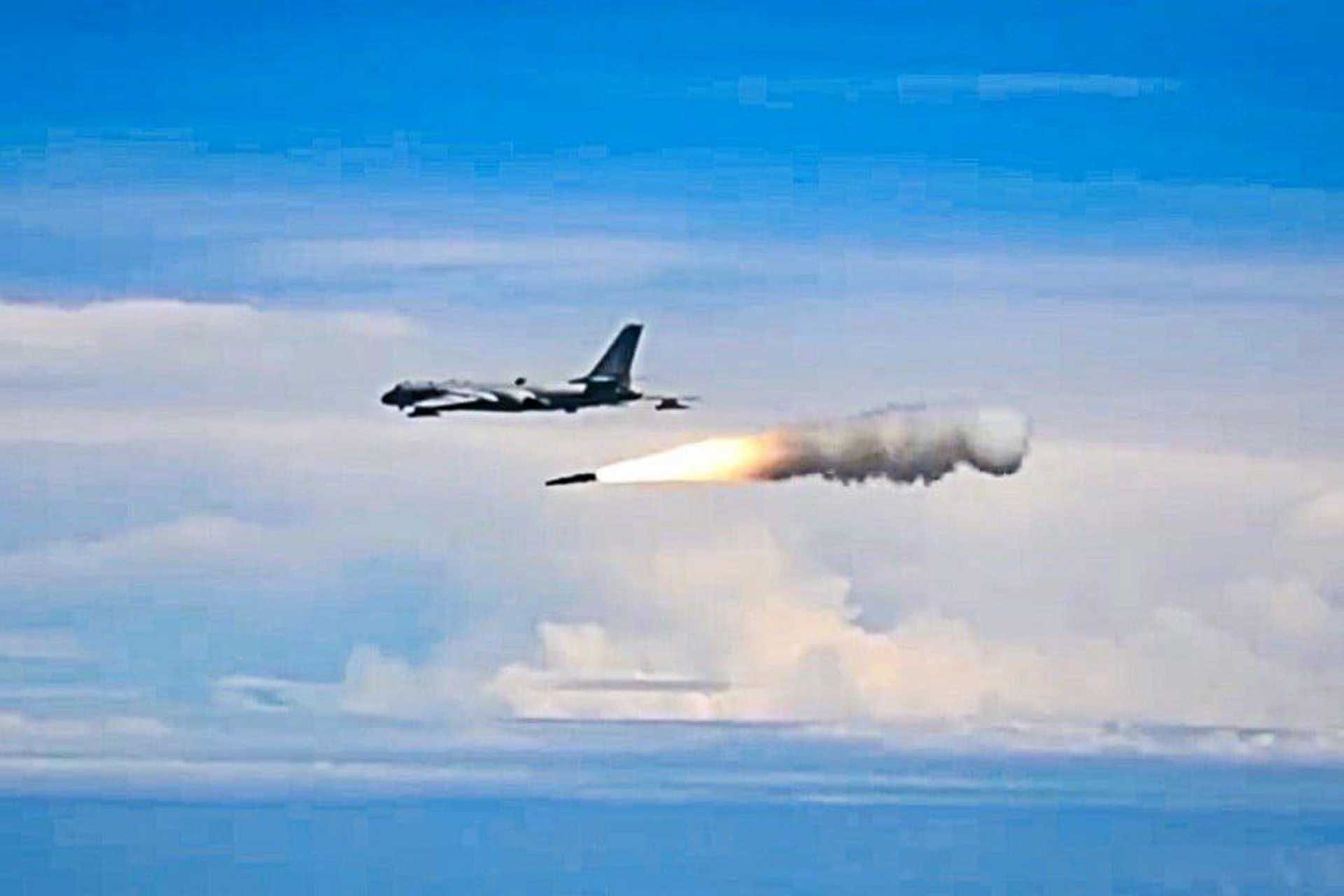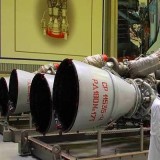Flash News: China Develops Secret Hypersonic Air-to-Air Missile Posing New Threat to US B-21 Stealth Bomber

{loadposition bannertop}
{loadposition sidebarpub}
China has officially confirmed the development of a highly advanced hypersonic air-to-air missile, marking a significant milestone in aerospace and defense technologies. This announcement was made public on January 19, 2025, via the “South China Morning Post”, a newspaper based in Hong Kong, after extensive testing, including extreme heat resistance trials designed to meet the stringent requirements of the People’s Liberation Army Air Force (PLAAF). The development of this missile poses a serious challenge to existing air defense systems. It could alter the dynamics of air superiority, particularly against high-tech aircraft like the U.S. B-21 Raider stealth bomber, which is currently undergoing flight testing.Follow Army Recognition on Google News at this link
Conceptual image of a cutting-edge hypersonic air-to-air missile, revolutionizing long-range aerial combat. (Picture source: China CCTV)
The confirmation of the missile’s existence was made through a paper published by Chinese scientists, revealing the sophisticated testing procedures employed, including the use of arc-heated wind tunnels. These special tunnels are designed to simulate the extreme conditions encountered by hypersonic vehicles, with temperatures reaching thousands of degrees Celsius—well beyond what conventional missiles experience. The heat-resistant tests are part of China’s effort to overcome one of the primary challenges of hypersonic flight: aerodynamic heating. At speeds greater than Mach 5, hypersonic missiles encounter intense friction with the atmosphere, which can cause temperatures to soar and potentially damage the missile’s structural integrity or disrupt its internal electronics. To ensure the missile’s reliability, China has conducted extensive trials, including those in high-cost wind tunnels typically used for space missions like simulating Mars landings.
Hypersonic air-to-air missiles are capable of traveling at speeds that exceed Mach 5, and as such, they present entirely new challenges and opportunities in air combat. Unlike traditional air-to-air missiles, which generally operate within a range of several hundred kilometers, hypersonic variants could strike targets as far as 1,000 km away or more, significantly extending the operational reach of platforms like China’s J-16 fighter. This increased range is not just a matter of distance, but also a matter of speed—hypersonic missiles can cover that ground much more quickly than their subsonic counterparts. With less time for an adversary to react, and an incredibly fast trajectory that evades interception, these missiles present a new type of threat for modern air forces. Conventional air-to-air missiles require complex guidance systems and long engagement times, while hypersonic missiles, due to their speed, can drastically shorten the time from launch to target impact, leaving little opportunity for escape.
The introduction of this weapon has serious implications for global air combat strategies, especially for the U.S. military and its allies. The U.S. B-21 Raider new stealth bomber, with its stealth capabilities and long-range strike capabilities, represents the cutting edge of American air power, but the threat of hypersonic weapons could force a reconsideration of how such aircraft are deployed in contested airspace. The B-21 was designed with the assumption that adversaries would rely on traditional anti-air threats, such as surface-to-air missiles and fighter jets. The hypersonic missile, however, could engage even the most advanced stealth bombers at ranges far beyond the capabilities of conventional interception systems, making them vulnerable in ways previously unimagined.
While China’s hypersonic air-to-air missile represents a new phase in military aerospace development, it is not alone in this endeavor. Other nations have also made significant strides in hypersonic and supersonic missile technology, some of which include air-to-air capabilities. The United States, for example, is actively working on a range of hypersonic missile systems through its various programs such as the Hypersonic Air-breathing Weapon Concept (HAWC) and the Air-launched Rapid Response Weapon (ARRW). These systems, while primarily intended for surface-to-air and air-to-ground applications, are indicative of the U.S.’s interest in keeping pace with China and Russia in the hypersonic race. In fact, the U.S. has been focusing efforts on deploying hypersonic missiles in various configurations, including for air-to-air engagements, albeit with a somewhat longer timeline for deployment than China.
Russia, too, has demonstrated significant progress in hypersonic technology with its Kinzhal missile, which, while primarily designed for air-to-ground strikes, is expected to serve as the basis for further developments in air-to-air variants. The Kinzhal is launched from a MiG-31 fighter jet and has already been used in combat, highlighting its potential in real-world scenarios. However, the focus for both the U.S. and Russia has largely been on using hypersonic systems for long-range strike missions rather than air-to-air combat, which is a niche that China appears to be pioneering.
The development of air-to-air supersonic and hypersonic missiles represents a new frontier in aerial warfare. These weapons offer far greater ranges and speeds than traditional air-to-air missiles, which are typically limited by their reliance on radar guidance and the necessity of in-flight updates from the launching platform. A hypersonic air-to-air missile, due to its sheer speed, could engage targets with little to no warning and without relying on extensive data links to ensure its accuracy. This dramatically changes the nature of air combat, as enemy aircraft—especially slower-moving tankers, bombers, and early warning platforms—will have limited options for evasion.
The strategic implications of this technology are profound. Air forces must now rethink their defense strategies in the face of such advanced missile technology. Countries with significant air forces, particularly the United States, will have to develop countermeasures capable of defeating or mitigating the effects of hypersonic missiles. This could involve developing better detection systems, faster interception capabilities, and more advanced electronic warfare tactics to thwart these high-speed threats.
The challenge is not only technological but also economic. Hypersonic systems, due to their complex engineering and high operating costs (such as the expense of running advanced wind tunnels), represent a significant investment. For now, only a handful of nations, including China, the U.S., and Russia, are investing heavily in this cutting-edge technology. However, as the missile race intensifies, other nations may also seek to develop their own variants, potentially changing the future balance of air superiority.
In conclusion, the Chinese hypersonic air-to-air missile marks a pivotal moment in the evolution of modern warfare, setting a new standard for the speed, range, and lethality of air-launched weapons. While other nations, including the U.S. and Russia, are working on their own hypersonic and supersonic missile technologies, China’s advancements in this area could lead to a shift in the tactical and strategic dimensions of aerial combat. The development of such weapons challenges not only current defense systems but also long-held assumptions about the effectiveness of traditional air-to-air missile engagements. As the world watches this technological race unfold, the implications for future air combat are both revolutionary and uncertain.

{loadposition bannertop}
{loadposition sidebarpub}
China has officially confirmed the development of a highly advanced hypersonic air-to-air missile, marking a significant milestone in aerospace and defense technologies. This announcement was made public on January 19, 2025, via the “South China Morning Post“, a newspaper based in Hong Kong, after extensive testing, including extreme heat resistance trials designed to meet the stringent requirements of the People’s Liberation Army Air Force (PLAAF). The development of this missile poses a serious challenge to existing air defense systems. It could alter the dynamics of air superiority, particularly against high-tech aircraft like the U.S. B-21 Raider stealth bomber, which is currently undergoing flight testing.
Follow Army Recognition on Google News at this link
Conceptual image of a cutting-edge hypersonic air-to-air missile, revolutionizing long-range aerial combat. (Picture source: China CCTV)
The confirmation of the missile’s existence was made through a paper published by Chinese scientists, revealing the sophisticated testing procedures employed, including the use of arc-heated wind tunnels. These special tunnels are designed to simulate the extreme conditions encountered by hypersonic vehicles, with temperatures reaching thousands of degrees Celsius—well beyond what conventional missiles experience. The heat-resistant tests are part of China’s effort to overcome one of the primary challenges of hypersonic flight: aerodynamic heating. At speeds greater than Mach 5, hypersonic missiles encounter intense friction with the atmosphere, which can cause temperatures to soar and potentially damage the missile’s structural integrity or disrupt its internal electronics. To ensure the missile’s reliability, China has conducted extensive trials, including those in high-cost wind tunnels typically used for space missions like simulating Mars landings.
Hypersonic air-to-air missiles are capable of traveling at speeds that exceed Mach 5, and as such, they present entirely new challenges and opportunities in air combat. Unlike traditional air-to-air missiles, which generally operate within a range of several hundred kilometers, hypersonic variants could strike targets as far as 1,000 km away or more, significantly extending the operational reach of platforms like China’s J-16 fighter. This increased range is not just a matter of distance, but also a matter of speed—hypersonic missiles can cover that ground much more quickly than their subsonic counterparts. With less time for an adversary to react, and an incredibly fast trajectory that evades interception, these missiles present a new type of threat for modern air forces. Conventional air-to-air missiles require complex guidance systems and long engagement times, while hypersonic missiles, due to their speed, can drastically shorten the time from launch to target impact, leaving little opportunity for escape.
The introduction of this weapon has serious implications for global air combat strategies, especially for the U.S. military and its allies. The U.S. B-21 Raider new stealth bomber, with its stealth capabilities and long-range strike capabilities, represents the cutting edge of American air power, but the threat of hypersonic weapons could force a reconsideration of how such aircraft are deployed in contested airspace. The B-21 was designed with the assumption that adversaries would rely on traditional anti-air threats, such as surface-to-air missiles and fighter jets. The hypersonic missile, however, could engage even the most advanced stealth bombers at ranges far beyond the capabilities of conventional interception systems, making them vulnerable in ways previously unimagined.
While China’s hypersonic air-to-air missile represents a new phase in military aerospace development, it is not alone in this endeavor. Other nations have also made significant strides in hypersonic and supersonic missile technology, some of which include air-to-air capabilities. The United States, for example, is actively working on a range of hypersonic missile systems through its various programs such as the Hypersonic Air-breathing Weapon Concept (HAWC) and the Air-launched Rapid Response Weapon (ARRW). These systems, while primarily intended for surface-to-air and air-to-ground applications, are indicative of the U.S.’s interest in keeping pace with China and Russia in the hypersonic race. In fact, the U.S. has been focusing efforts on deploying hypersonic missiles in various configurations, including for air-to-air engagements, albeit with a somewhat longer timeline for deployment than China.
Russia, too, has demonstrated significant progress in hypersonic technology with its Kinzhal missile, which, while primarily designed for air-to-ground strikes, is expected to serve as the basis for further developments in air-to-air variants. The Kinzhal is launched from a MiG-31 fighter jet and has already been used in combat, highlighting its potential in real-world scenarios. However, the focus for both the U.S. and Russia has largely been on using hypersonic systems for long-range strike missions rather than air-to-air combat, which is a niche that China appears to be pioneering.
The development of air-to-air supersonic and hypersonic missiles represents a new frontier in aerial warfare. These weapons offer far greater ranges and speeds than traditional air-to-air missiles, which are typically limited by their reliance on radar guidance and the necessity of in-flight updates from the launching platform. A hypersonic air-to-air missile, due to its sheer speed, could engage targets with little to no warning and without relying on extensive data links to ensure its accuracy. This dramatically changes the nature of air combat, as enemy aircraft—especially slower-moving tankers, bombers, and early warning platforms—will have limited options for evasion.
The strategic implications of this technology are profound. Air forces must now rethink their defense strategies in the face of such advanced missile technology. Countries with significant air forces, particularly the United States, will have to develop countermeasures capable of defeating or mitigating the effects of hypersonic missiles. This could involve developing better detection systems, faster interception capabilities, and more advanced electronic warfare tactics to thwart these high-speed threats.
The challenge is not only technological but also economic. Hypersonic systems, due to their complex engineering and high operating costs (such as the expense of running advanced wind tunnels), represent a significant investment. For now, only a handful of nations, including China, the U.S., and Russia, are investing heavily in this cutting-edge technology. However, as the missile race intensifies, other nations may also seek to develop their own variants, potentially changing the future balance of air superiority.
In conclusion, the Chinese hypersonic air-to-air missile marks a pivotal moment in the evolution of modern warfare, setting a new standard for the speed, range, and lethality of air-launched weapons. While other nations, including the U.S. and Russia, are working on their own hypersonic and supersonic missile technologies, China’s advancements in this area could lead to a shift in the tactical and strategic dimensions of aerial combat. The development of such weapons challenges not only current defense systems but also long-held assumptions about the effectiveness of traditional air-to-air missile engagements. As the world watches this technological race unfold, the implications for future air combat are both revolutionary and uncertain.





